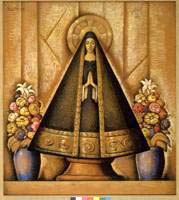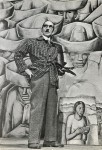
Alfredo Ramos Martinez
Mexican, 1871-1946 (active Mexico, United States, France)
La Virgen de San Juan, 1940 ca.
oil on pressed board
29 1/4 x 26 1/4 in.
SBMA, Gift of Mrs. Allen M. Reed in memory of her sister Julia Belle Faurot Tolson
1979.8.2

POSTSCRIPT
The history of the Virgen de San Juan de los lagos has its roots in the religious experience of a people who have felt the very close presence of Mary, the Mother of God, in their lives. A small statue of the Immaculate Conception was placed by the first Spanish missionaries in a church in the town of San Juan de Los Largos, in Jalisco, Mexico. In 1623, through Mary's intercession, a young girl was brought back to life, and this image of Mary then became known as La Virgen de San Juan de los Lagos.

Our Lady of San Juan Prayer Card: We pray that you, most Holy and Immaculate Virgin of San Juan guide us throughout our life. Please make us mindful of the needs of others and also help them through our prayers. Give us the spiritual strength so that we are close to your Son, Jesus, and through him may Have love and compassion for others. Grant us peace and happiness.
COMMENTS
Alfredo Ramos Martinez was born on November 12, 1871, in Monterrey, in the state of Nuevo Leon, in Mexico. His father, Jacobo Ramos, a middle-class storekeeper, and his mother, Luisa Martinez de Ramos were strongly supportive of young Alfredo’s artistic endeavors and at the impressionable age of only nine years old, he sent a portrait he had painted of the governor of Nuevo Leon to a competition in San Antonio, Texas and was awarded first prize.
Ramos Martinez spent eight years at the prestigious Escuela Nacional de Bellas Artes in Mexico City; an experience that left him resentful, as he believed the system devalued any sense of individuality in an artist.
Fed up with the monotony of drawing from plaster casts, he often wandered away from the academy to paint scenes from ordinary life. In 1899 his work caught the attention of American Phoebe Hearst, who arranged to financially support his studies abroad. In 1900, he arrived in Paris where he spent 10 years and continued his studies in the streets of the city embracing the style of the Impressionism and Post-Impressionism.
It was here in Europe that Ramos Martinez began to paint on newsprint. As he explained later in an interview, while visiting Brittany in preparation for his Salon exhibition, he ran out of sketch paper. He asked his landlord if he had access to any good paper. When the landlord returned, he offered Ramos Martinez a stack of newspapers, which the artist reluctantly accepted.
Ramos Martinez returned to Mexico in 1910 and the following year he was appointed Assistant Director of the Escuela Nacional de Bellas Artes.. Although he protested at first, "no, not I –I am the enemy of all academies," he later accepted the offer when he realized he had strong support from the students. He then opened the first of his Escuelas de Pintura al Aire Libre (Open Air Schools of Painting) with an enrollment of ten boys, including a rebellious youth named David Alfaro Siqueiros, soon to become one of the most important Mexican muralists. Taking its cue from the Impressionist concept of painting in the outdoors, this revolutionary program initiated changes in both the theoretical and practical approaches to painting in Mexico bringing arts education within the reach of people of all walks of life. Modernist painter Rufino Tamayo, who studied at the Escuela Nacional de Bellas Artes from 1917 through 1921, credited Ramos Martinez for directing him "toward Impressionism."
Ramos Martinez married Maria de Sodi Romero in 1928 and a year later their daughter, Maria, was born with a crippling bone disease. Greatly grieved by her suffering, Ramos Martinez and his family left Mexico in 1929 seeking medical attention for her in the United States. They settled in Los Angeles where her condition was successfully treated. These circumstances would catapult Ramos Martinez’s art in a new direction. The works produced in California at this time are abruptly modern, yet they focus on prevailing themes of the Mexican renaissance. He turns to the subjects he adored: the humble yet monumental Indian, the dramatic landscapes of Mexico and religious themes that reveal the fervent spirituality shared by his people. He explores the parameters of volume and space in his enormous oil on canvas portraits and his lyrical language of line and color are revealed in his elegant gouaches. The tender embrace of a mother and child, a grouping of vendedoras masterfully balancing baskets of abundant, colorful fruit on their heads, or a depiction of a processional of indigenous women dressed in warm tones of yellows and golds paying homage to the pre-Colombian deity, Quetzalcoatl, are beautifully rendered and even further dramatized by the texture of his chosen medium of newsprint.
The serious bone disease of his only child brought Ramos Martinez and his family to Los Angeles in 1929 in search of specialized medical treatment. He exhibited his paintings in local museums and galleries, and received residential mural commissions from such Hollywood celebrities as screenwriter Jo Swerling, designer Edith Head, and director Alfred Hitchcock. In 1934 he did a set of murals for the chapel of Santa Barbara Cemetery. In 1937 he painted a fresco over the main portal of the Church of Mary, Star of the Sea in La Jolla (in San Diego County).
Ramos Martinez was commissioned to paint numerous murals throughout the United States and Mexico including, the celebrity homes of Jo Swerling, Edith Head and Beulah Bondi, the Chapman Park Hotel, Scripps College in Claremont California and the Normal School for Teachers in Mexico City. His work was exhibited throughout California including the Los Angeles County Museum, the Assistance League Gallery in Hollywood, the Faulkner Gallery in Santa Barbara, and the San Francisco Museum of Art. In 1945, he had a one-man show at the Dalzell Hatfield Galleries and the following year at Lillenfeld Gallery in New York City.
After his death in 1946, his works were highlighted in several memorial retrospectives including Dalzell-Hatfield Galleries in 1951-1952, Los Angeles City College in 1953, at Scripps College in 1956 and in 1975 the Dalzell-Hatfield Galleries featured "Alfredo Ramos Martinez: A Treasure Trove Exhibition." In 1992, Louis Stern Galleries presented a prominent retrospective exhibition of his work and continues to represent the estate.
Although considered by many to be the founding father of Modern Mexican Art, Ramos Martinez’s astounding contributions to the development of Mexican and Southern Californian art has been dramatically overlooked. A prolific painter and an innovative teacher, Ramos Martinez has been a victim of circumstance; an inexplicable lapse in memory. At a time when Mexican art gained great momentum with the Mexican Muralist movement with such recognizable names as Diego Rivera and Jose Clemente Orozco, Ramos Martinez’s substantial artistic vision had all been but erased. However, a truly great artist remains just that. "If Mexican modernism…is the product of the 1910 Revolution, which projected not only a utopian vision of the future, but also a return to Mexico’s roots," as Hans Haufe states, "Ramos Martinez stands among the painters that initiated that movement." His legacy lives on and his work is now gaining the recognition it deservedly needs.
http://rogallery.com/Martinez_Alfredo_Ramos/martinez-biography.html
Los Angeles Time Art Critic Christopher Knight discusses Ramos Martinez' drawings on newsprint in art historical and socio-economic context in the review of the exhibition "Picturing Mexico: Alfred Ramos Martinez in California" at the Pasadena Museum of California Art, January through April 20, 2014. See the full review printed in the Calendar section of the Tuesday, January 28, 2014 Los Angeles Times here:
http://www.latimes.com/entertainment/arts/culture/la-et-cm-alfredo-ramos-martinez-review-20140128,0,6158800.story#axzz2rjN2jZNb
SBMA CURATORIAL LABELS
In 1929, Alfredo Ramos Martínez welcomed the birth of daughter Maria, but not without adversity. Born with a congenital bone disease, doctors recommended a warm, dry climate for the ailing infant. The following year, the artist moved the family to Los Angeles. Deeply grieved by her condition, Ramos Martínez began depicting religious subjects while also painting portraits of his daughter as a means of healing.
- SBMA title card, 2013
